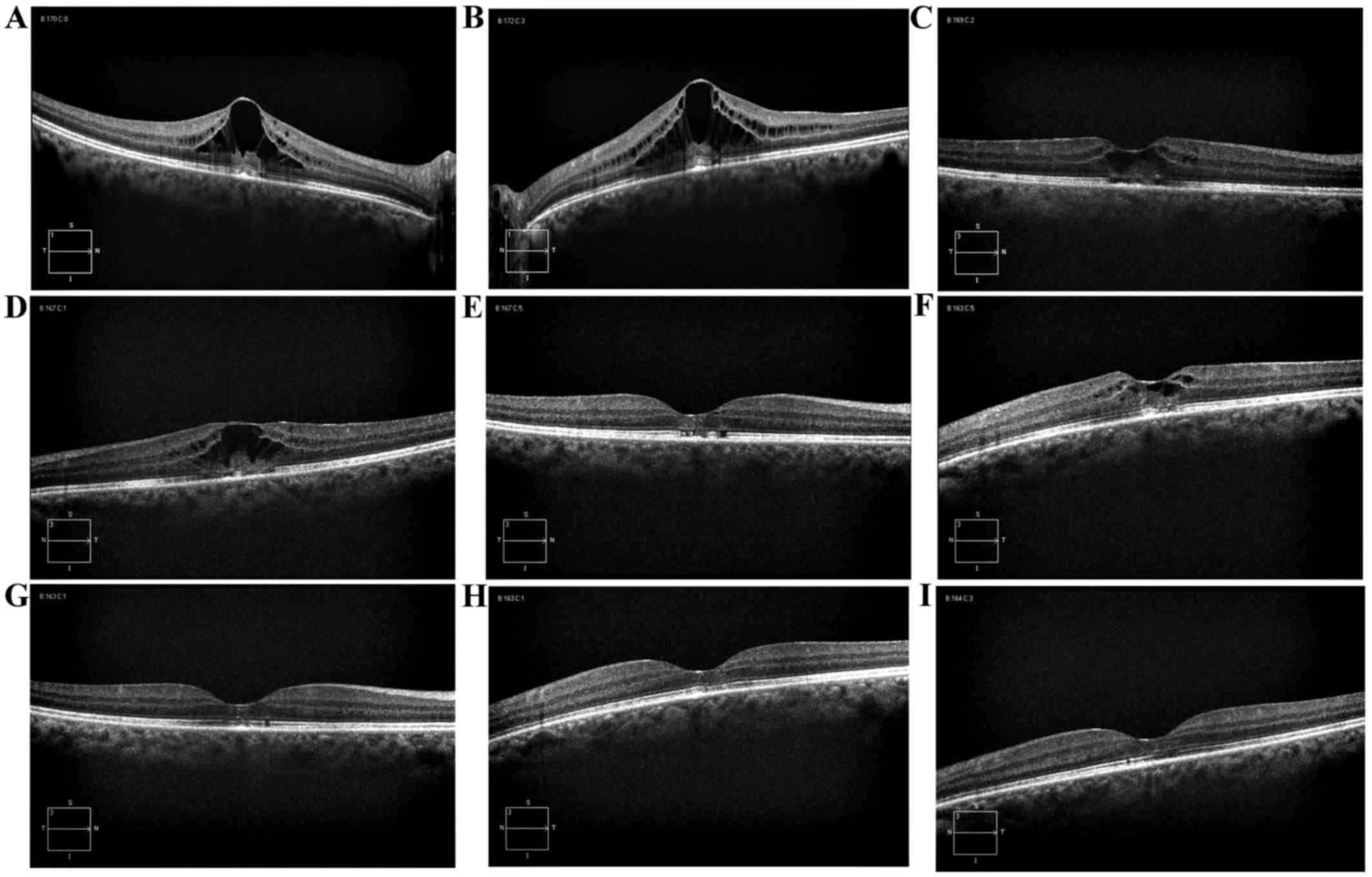Cystoid macular edema secondary to paclitaxel therapy for ovarian cancer: A case report
- Authors:
- Emma Bassi
- Vera Loizzi
- Claudio Furino
- Rosa Martino
- Giovanni Alessio
- Cicinelli Ettore
- Gennaro Cormio
View Affiliations
Affiliations: Department of Biomedical Science and Human Oncology, Obstetrics and Gynecology Unit, University of Bari, I-70124 Bari, Italy, Department of Ophthalmology, University of Bari, I-70124 Bari, Italy
- Published online on: June 21, 2017 https://doi.org/10.3892/mco.2017.1296
-
Pages:
285-287
Metrics: Total
Views: 0 (Spandidos Publications: | PMC Statistics: )
Metrics: Total PDF Downloads: 0 (Spandidos Publications: | PMC Statistics: )
This article is mentioned in:
Abstract
Paclitaxel is a member of the taxane agents that has demonstrated efficacy in ovarian cancer, both in first- and in second-line therapy. Counted among the side-effects of this drug are neurological disorders. In the present study, a rare case of a non-neuropathic ocular disorder, known as cystoid macular edema (CME), due to paclitaxel in patients treated for ovarian cancer is described. Macular edema, or CME, is a common cause of visual impairment that has been classically demonstrated by fluorescein angiograms, showing capillary leakage. CME without fluorescein leakage is rare, and its most common causes are juvenile X-linked retinoschisis, Goldmann-Favre syndrome, and niacin toxicity. At the present time, the mechanism associated with the form of CME that does not exhibit any signs of fluorescein leakage has not been elucidated due to an absence of histopathological studies. Several mechanisms have been proposed, although it is considered to occur due to disruption of the normal blood-retinal barrier by molecules with a molecular weight lower than that of fluorescein, which leads to fluid accumulation in the intracellular space. It is well known that taxane agents cause fluid retention, represented by edema, weight gain, and third-space fluid collection (pericardial, pleural, ascites), and this appears to be associated with their cumulative dose. The present case study confirms that macular edema associated with paclitaxel use exhibits spontaneous resolution following discontinuation of the causative agent. Taxane-associated maculopathy has been scarcely reported in the literature, but the gynecological oncologist should be alert to its possible development, and an ophthalmologic evaluation should be offered to all patients using paclitaxel.
View References
|
1
|
Boere IA and van der Burg ME: Review of
dose-intense platinum and/or paclitaxel containing chemotherapy in
advanced and recurrent epithelial ovarian cancer. Curr Pharm Des.
18:3741–3753. 2012. View Article : Google Scholar : PubMed/NCBI
|
|
2
|
Oishi R and Egashira N: Fukuoka.
Peripheral neuropathy induced by anticancer drugs. IgakuZasshi.
104:71–80. 2013.
|
|
3
|
Hofstra LS, de Vries EG and Willemse PH:
Ophthalmic toxicity following paclitaxel infusion. Ann Oncol.
8:10531997. View Article : Google Scholar : PubMed/NCBI
|
|
4
|
Li J, Tripathi RC and Tripathi BJ:
Drug-induced ocular disorders. Drug Saf. 31:127–141. 2008.
View Article : Google Scholar : PubMed/NCBI
|
|
5
|
Semb KA, Aamdal S and Oian P: Capillary
protein leak syndrome appears to explain fluid retention in cancer
patients who receive docetaxel treatment. J Clin Oncol.
16:3426–3432. 1998. View Article : Google Scholar : PubMed/NCBI
|
|
6
|
Spirn MJ, Warren FA, Guyer DR, Klancnik JM
Jr and Spaide RF: Optical coherence tomography findings in
nicotinic acid maculopathy. Am J Ophthalmol. 135:913–914. 2003.
View Article : Google Scholar : PubMed/NCBI
|
|
7
|
Telander DG and Sarraf D: Cystoid macular
edema with docetaxel chemotherapy and the fluid retention syndrome.
Semin Ophthalmol. 22:151–153. 2007. View Article : Google Scholar : PubMed/NCBI
|
|
8
|
Michaud LB, Valero V and Hortobagyi G:
Risks and benefits of taxanes in breast and ovarian cancer. Drug
Saf. 23:401–428. 2000. View Article : Google Scholar : PubMed/NCBI
|
|
9
|
Béhar A, Pujade-Lauraine E, Maurel A, Brun
MD, Chauvin FF, de Chauvin F Feuilhade, Oulid-Aissa D and Hille D:
The pathophysiological mechanism of fluid retention in advanced
cancer patients treated with docetaxel, but not receiving
corticosteroid comedication. Br J Clin Pharmacol. 43:653–658. 1997.
View Article : Google Scholar : PubMed/NCBI
|
|
10
|
Koo NK and Kim YC: A case of
paclitaxel-induced maculopathy treated with methazolamide. Korean J
Ophthalmol. 26:394–397. 2012. View Article : Google Scholar : PubMed/NCBI
|
|
11
|
Teitelbaum BA and Tresley DJ: Cystic
maculopathy with normal capillary permeability secondary to
docetaxel. Optom Vis Sci. 80:277–279. 2003. View Article : Google Scholar : PubMed/NCBI
|
|
12
|
Murphy CG, Walsh JB, Hudis CA, Lake D and
Theodoulou M: Cystoid macular edema secondary to nab-paclitaxel
therapy. J Clin Oncol. 28:e684–e687. 2010. View Article : Google Scholar : PubMed/NCBI
|
|
13
|
Smith SV, Benz MS and Brown DM: Cystoid
macular edema secondary to albumin-bound paclitaxel therapy. Arch
Ophthalmol. 126:1605–1606. 2008. View Article : Google Scholar : PubMed/NCBI
|
|
14
|
Joshi MM and Garretson BR: Paclitaxel
maculopathy. Arch Ophthalmol. 125:709–710. 2007. View Article : Google Scholar : PubMed/NCBI
|
|
15
|
Risard SM, Pieramici DJ and Rabena MD:
Cystoid macular edema secondary to Paclitaxel (abraxane). Retin
Cases Brief Rep. 3:383–385. 2009. View Article : Google Scholar : PubMed/NCBI
|
|
16
|
Georgakopoulos CD, Makri OE, Vasilakis P
and Exarchou A: Angiographically silent cystoid macular oedema
secondary to paclitaxel therapy. Clin Exp Optom. 95:233–236. 2012.
View Article : Google Scholar : PubMed/NCBI
|
|
17
|
Baskin DE and Garg SJ: Abraxane-induced
cystoid macular edema refractory to concomitant intravenous
bevacizumab. Can J Ophthalmol. 46:200–201. 2011. View Article : Google Scholar : PubMed/NCBI
|










